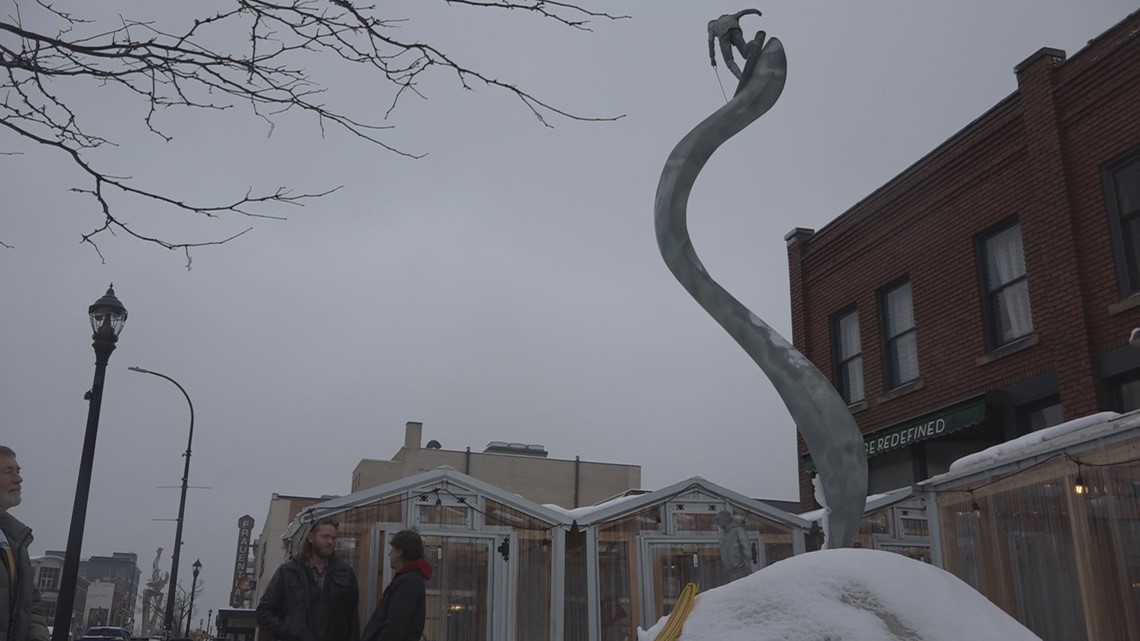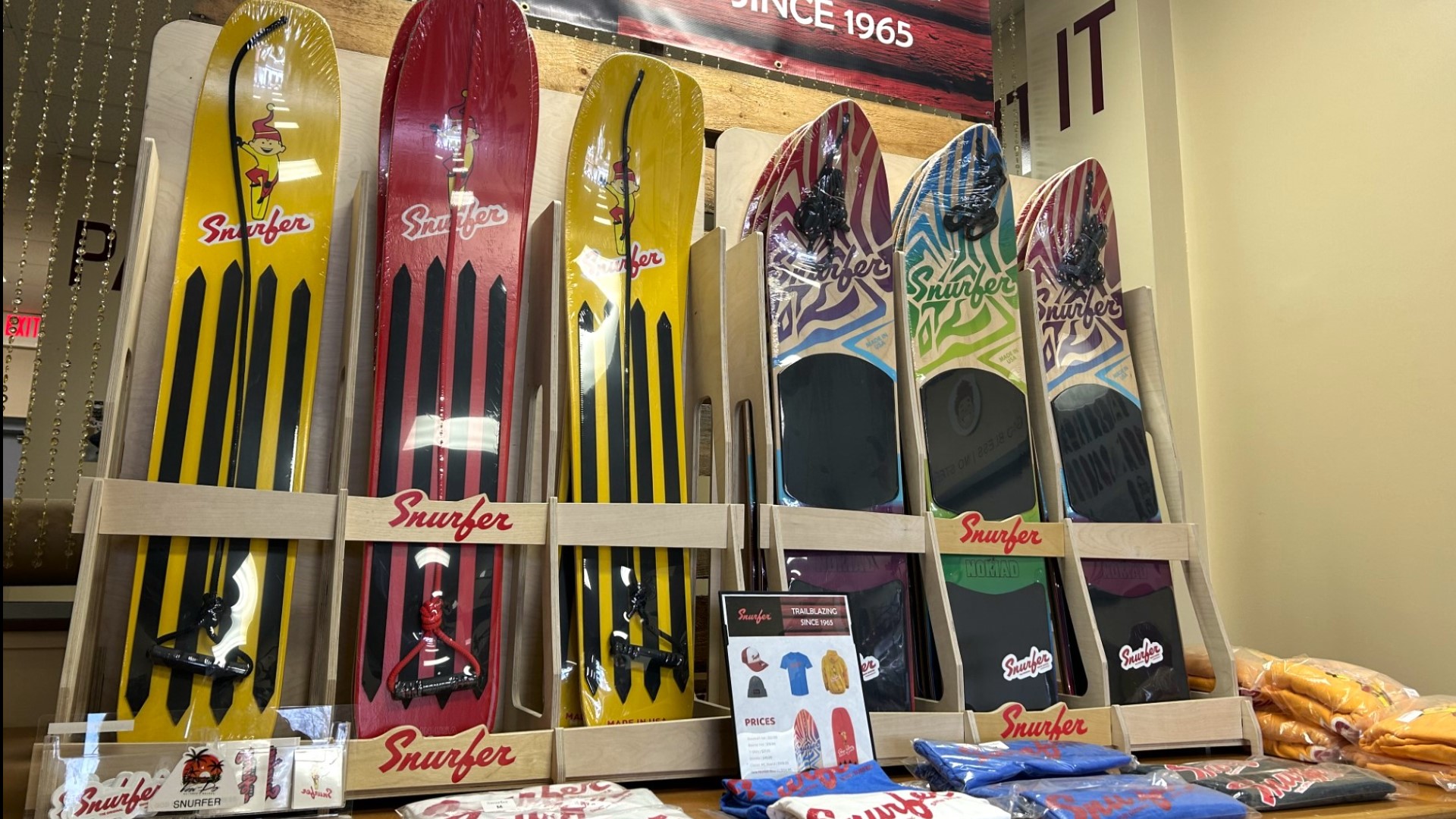MUSKEGON, Michigan — In this winter weather, many are grabbing their sleds and boards and heading to the hills. But what many might not know is they have one West Michigan city to thank for their favorite winter activity.
“I'm always fascinated by those little oddball items that you stumble upon,” said Ron Pesch, a Muskegon historian.
Inside a little hut covered by snow outside a barbecue restaurant in downtown Muskegon, Ron kept warm with some light reading when he met with 13 ON YOUR SIDE.
“Choosing between in a book of fiction, or a book of nonfiction, and I'll pick nonfiction every day of the week,” he said. "I'm just an individual always interested in fact."
He's pouring over a scrapbook filled with keepsakes of his research. It's research that helped turn his hometown into a legend.
“This little town on the shores of Lake Michigan is the place where snowboarding got a start.," Ron smiled.
Just like many stories of invention before, this one begins with a tired mom.
“Sherm Poppen was the father of two daughters. His wife, Nancy, was pregnant with her third daughter," said Ron. “On Christmas day, she told Sherm, 'you got to take the kids, I need a nap.' And so he took his daughters outside.”
The snow was too powdery and fresh to hold up their sled. Playtime could've been over before they knew it. But Sherm had an idea.
“He went back to his workshop, grabbed his daughter's youth skis, strapped them together, and had the kids playing on that," said Ron. “What he'd done was created what was the prototype for what he called the Snurfer, or I should say is his wife Nancy called it the Snurfer.”
The name is a mix between snow and surfing. When Nancy looked out her window to see them playing, she said it looked like they were surfing on the snow.
“That board today resides with Smithsonian," Ron said.
Though it was born on a quick solution, the new board’s longevity was anything but.
“Their product… was released by Brunswick Corporation as a product available for purchase for Christmases," said Ron.
From there, it would snowball.
"It was and is generally recognized as the birth of what became the snowboard," he said.
It earned Muskegon a place in history and earned Mike Medendorp a gold trophy.
“About 1968, the neighborhood heard about these snowboards. Everybody was getting a snowboard and sliding down the hills. And I wanted one for Christmas," said Mike.
Now 70, he remembers this faded plank of wood topped with rusted staples as a symbol of the glory days.
After the emergence of snurfing all over West Michigan, Muskegon Community College set up a competition in 1970. They called it the World's Snurfing Champion because there was an international student at the college who wanted to compete.
Mike couldn't wait to enter.
“I won in 1970," he smiled. “I'm the world's champion Snurfer. That's my claim to fame. And I'm very proud of that.”
At the World Snurfing Champion, Jake Burton Carpenter came from out-of-state to compete one year. He made so many modifications to his Snurfer that judges wouldn't let him compete in the general category. He created a new one, and prize money was split $750 to Snurfers, $250 to others.
Jake took home the $250 prize and started selling boards with some upgrades. Sherm Poppen told him he could sell his boards, just not under his brand name.
Years later, Jake would become the inventor of the snowboard based on those modifications. Soon enough, Burton Snowboards were a household name.
"Years later, Sherm Poppen would always say the biggest mistake that he made was enforcing his trademark," said Ron. "Had he not done that, we might be competing in the Olympics on Snurfers instead of snowboards.”
For Mike, it was never about the money, though. It was about the feeling on that board.
“You stand on it sideways, your feet are crossways to the board and you have a rope on the front of the board, you hang on to the rope. You just scoot a little bit. Slide down the hill and you use your ankles to turn the board you lean," he explained, “It’s like flying down a hill."
Just outside that little hut of history in downtown Muskegon, where 13 ON YOUR SIDE talked with Ron and Mike, sits a memento much bigger.


It's a sculpture honoring the origin of snurfing in West Michigan, called "The Turning Point," created by Colorado artist Jason Dreweck and his mom, Teresa Hansen. At the top is a girl on her Snurfer and at the bottom of a long spiral is a snowboarder.
The girl at the top is meant to represent Sherm's daughter making the inaugural Snurfer ride.


“People don't go visit cities to visit their McDonald's. They visit cities for the stories that are there," said Ron, gesturing to the sculpture, "This solidifies that story to them, and they walk away with something that they didn't know before.”
It's a 14-foot steel reminder of the place where snowboarding was first thought of. And it's a symbol that Ron's research is working.
“I don't think anybody be it a city or a person wants to be erased from history," he said. “You need to tell the stories to make sure that you embrace that history.”
But that leaves one question. Can you still even buy a Snurfer today?
The answer is yes. But not at a place you'd expect.
“Pak Mail in Spring Lake," smiled employee Mason Mitchell. "We sell the Snurfer, which has been trailblazing since 1965.”
Mason and his crew at Pak Mail have been working to bring back a new, old favorite. On top of their printing and packaging duties, of course.
“It's for ages like 5 to honestly 60 If you want it to, it's for anybody and everybody," he said. "It's cool because you can do it anywhere you don't have to have a lift ticket.”
Just as Sherm Poppen did all those years ago, he’s making a bit of history in the process. Pak Mail is the only store that sells Snurfers right now.
"Hopefully they'll grow," he smiled. "This is big. This is legendary."
A shipping store in Spring Lake — where history begins again.
"That is one of the reasons why people like coming here. And obviously shipping out things, too," Mason laughed.
►Make it easy to keep up to date with more stories like this. Download the 13 ON YOUR SIDE app now.
Have a news tip? Email news@13onyourside.com, visit our Facebook page or Twitter. Subscribe to our YouTube channel.
Watch 13 ON YOUR SIDE for free on Roku, Amazon Fire TV Stick, Apple TV and on your phone.

